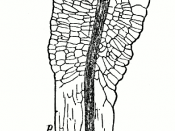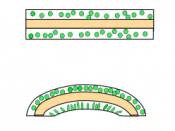Involvement of K+ in Leaf Movements During Suntracking
Introduction
Many plants orient their leaves in response to directional light signals. Heliotropic movements, or movements that are affected by the sun, are common among plants belonging to the families Malvaceae, Fabaceae, Nyctaginaceae, and Oxalidaceae. The leaves of many plants, including Crotalaria pallida, exhibit diaheliotropic movement. C. pallida is a woody shrub native to South Africa. Its trifoliate leaves are connected to the petiole by 3-4 mm long pulvinules (Schmalstig). In diaheliotropic movement, the plant's leaves are oriented perpendicular to the sun's rays, thereby maximizing the interception of photosynthetically active radiation (PAR). In some plants, but not all, his response occurs particularly during the morning and late afternoon, when the light is coming at more of an angle and the water stress is not as severe (Donahue and Vogelmann). Under these conditions the lamina of the leaf is within less than 15ð from the normal to the sun.
Many plants that exhibit diaheliotropic movements also show paraheliotropic response as well. Paraheliotropism minimizes water loss by reducing the amount of light absorbed by the leaves; the leaves orient themselves parallel to the sun's rays. Plants that exhibit paraheliotropic behavior usually do so at midday, when the sun's rays are perpendicular to the ground. This reorientation takes place only in leaves of plants that are capable of nastic light-driven movements, such as the trifoliate leaf of Erythrina spp. (Herbert 1984). However, this phenomenon has been observed in other legume species that exhibit diaheliotropic leaf movement as well. Their movement is temporarily transformed from diaheliotropic to paraheliotropic. In doing so, the interception of solar radiation is maximized during the morning and late afternoon, and minimized during midday. The leaves of Crotalaria pallida also exhibit nyctinastic, or sleep, movements, in which the leaves fold down...


